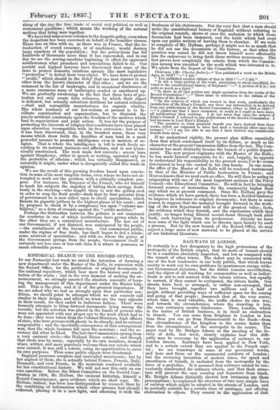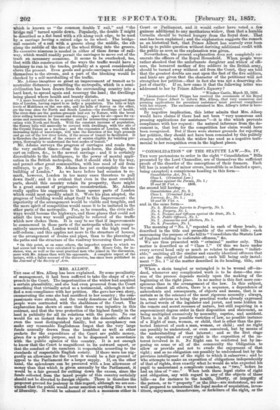RAILWAYS IN LONDON.
Ix certainly is a fact derogatory to the high pretensions of the metropolis of the British empire, that its mode of transit should be in a condition absolutely imperfect, and low as compared with the transit of other towns. The defect may be connected with one of the best tendencies in our body politic, that which leaves society to work out its own problems by spontaneous energy without Government dictation; but the defect remains nevertheless, and the object of all teaching for communities as well as individuals is not to rest content with the inborn virtues, but equally to correct, if they cannot be extirpated, the inborn faults. Our streets have been so arranged, or rather non-arranged, that they have brought together two millions and a half of people without providing ways of sufficient space for the coming and going of that people ; insomuch that at the very centre, where time is most valuable, the traffic chokes its own way, and towards the circumference, where the crowding is less, the very extension creates hinderanee. Thus, London, which is the centre of British business, is in itself an obstruction to transit. You can come from Brighton to London in less time than you can go from Hammersmith to the Bank—from the circumference of the kingdom to the centre faster than from the circumference of the metropolis to its centre. The paper read by Mr. Bridges Adams at the meeting of the Society of Arts, last week, clearly explains how this difficulty may be overcome by the application of railways to our London streets. Railways have been applied to New York, and to a certain extent they are applied to the French capital ; we see tramways in some of our provincial towns, and here and there on the commercial outskirts of London ; but the crowning invention of modern times, for speed and smoothness of transit, is excluded from the metropolis by the force of a prejudice. It is assumed that railways cannot be conveniently constructed for ordinary wheels, and that their structure will prevent the easy crossing and departure from track. Mr. Bridges Adams distinctly showed how erroneous are these presumptions; he explained the structure of two very simple lines of railway which might be adopted in the streets of London, and be perfectly suitable for a certain class of carriages, not offering obstruction to others. They consist in the application of that which is known as "the common. double T rail," and "the bridge rail" turned upside down.. Popularly, the double T might be described as a fiat band with a rib along each edge, to be used by a carriage having a raised edge to its wheel. The bridgerail consists of a rail with a groove along the middle, the rib along the middle of the tire of the wheel fitting into the groove. No excessive niceness is needed in either of these forms of railway, which would readily permit the carriages to move out of the track on necessary occasions. It seems to be overlooked, too, that with this construction of the ways the traffic would have a tendency to run in the tracks, probably at a speed considerably above the present. Even goods and goods-carriages would adapt themselves to the stream and a part of the blocking would be checked by a self-marshalling of the traffic. Mr. Adams imagines so great an improvement of transit as to neutralize distances ; permitting the metropolis, which in a semicivilization has been drawn from the surrounding country into a hard knot, to spread again and reoccupy the land ; the dwellings being placed where health and beauty dictate. "A more beautiful site for a great city could not well be imagined than this of London, having regard to so lafge a population. The hills or high levels of Middlesex on the one aide, and the lulls of Surrey on the other, are the true sites for North and South London—the dwellings of health. The river-flats are the garden-grounds laid out by Nature, with the broad river rolling between for transit and drainage; space for air—space for exercise and recreation in fine weather, and for intersecting roads communicating with North and South. With the constant increase of population, the Surrey hills will assuredly be covered with dwellings, with the site of the Crystal Palace as a nucleus • and the expansion of London with the increasing light of knowledge, 'All take the direction of the high grounds and go out of the low river levels, if the means of transit be facilitated. 'toted. It is Therefore the interest of the owners of estates eligible for building purposes thoroughly to understand the best modes of transit." ML Adams surveys the progress of carriages and roads from the very earliest times—from the pack-horse, the sledge the cart on rollers, &o., to the newest carriage : and it is certainly discreditable to the intelligence, to the power of mental application in the British metropolis, that it should stick by the way, and permit other great communities, with less need of aid from railways, to go by. Mr. Adams does not contemplate the unbuilding of London.* As we have before had occasion to remark, however, London in too many cases threatens to pull down itself; and it is evident that even in the most crowded parts, should this country retain its prosperity, there might be a great amount of progressive reconstruction. Mr. Adams really applies his suggestion to those opener parts of London which could most speedily admit it. Were his plan adopted, the progress of building would adapt itself to this improvement: the superiority of the arrangement would be visible and tangible, and the mere spirit of competition would cause it to be imitated in the ether parts of the metropolis. For, as he remarks, the civic railways would become the highways, and those places that could not admit the iron way would gradually be relieved of the traffic which now chokes them. It is easy to see that if improvements be commenced in those parts of the metropolis which are comparatively uncrowded, London would be put on the high road to. self-reform; and this applies not more to the structure of houses, or the arrangement of drains and piped, than to the planning of the paths and the structure of the roadway traversing those paths.
* On this point, as on some others, the imperfect reports to which we had access last week -were calculated to mislead. Mr. Henry Cole for instance, was, as well as the most practical men -who joined in the discussion, more with Mr. Adams than with his opponents. A complete report of the lecture, with a fuller account of the discussion, has since been published in the Journal of the Society of Arts.



























 Previous page
Previous page